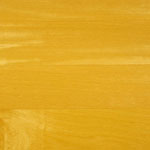Serving Upstate NY—VT—MA • For selections & prices, CALL or EMAIL US
Yellowheart (Satinwood)
Grades & Properties of Wood Flooring —
Exotic Species
Scientific Name:
Euxylophora paraensis (Brazilian Satinwood) or
Zanthoxylum flavum (West Indian Satinwood)
Other Common Names and Related Species:
- Aceitillo
- Bois Noyer
- Bois Noyes
- Brazilian Satinwood
- Espinillo
- Jamaican Sandalwood
- Kalabarie
- Pau Amarello
- Prickly Ash
- Tembetaria
- West Indian Satinwood
- Yellow Sandalwood
- Yellow Sanders
- Yellow Wood
Shop online now for Yellowheart Flooring »
Origin:
Brazil and throughout continental tropical America.
Janka Hardness: 1820
Yellowheart’s hardness is the same as that of Hickory.
Grades of Yellowheart Flooring:
Clear grade Yellowheart flooring is color-sorted for a light yellow color. Clear grade is usually the only grade available.
Yellowheart Flooring Dimension Specifications:
Although it is usually more cost-effective to import finished material than raw lumber. Pre-milled flooring is not available in Yellowheart. Raw lumber must be obtained and the flooring must be milled here in the United States. Typically, the lengths can develop up to 12 feet. However, the cost can be double that of the pre-milled stock because of waste and labor costs in the United States. Moisture content is between 6% and 8% for quick acclimation. Also, raw lumber is relatively expensive because it is taxed more heavily than finished products to support local economies in South America.
Flooring Availability:
Satinwood is normally sold unfinished. It can be custom-prefinished or unfinished in solid form for nail-down applications and in engineered form with a veneer top layer for application over concrete. Yellowheart is an uncommon species in comparison with Brazilian Cherry and Brazilian Teak. There is a moderate amount of Yellowheart in South America, and it is not endangered. However, less logging, stricter regulations, the decking market, and a slower American economy have limited commodities and caused slightly higher prices of this product in this country.
Finished Floor Appearance:
A Clear grade floor will have an even yellow appearance. Oil-based finishes allow Yellowheart to age to a light brown color. Lacquer or de-waxed shellac can be first applied to help preserve the distinctive brownish yellow color of the wood and will help with drying time. Water-based finishes will preserve the natural color longer.
Flooring Durability and Stability:
Yellowheart flooring is moderately hard. It harder than most North American floors because of its density but can swell with moisture if not acclimated properly.
Workability of Yellowheart Flooring:
Although hard, Yellowheart flooring works with little difficulty with both hand and power tools. When installing the flooring, it is best to use a manual nailer, but staples and pneumatic nailers can be used. It holds screws well, and it glues, stains, and polishes to a very attractive finish. It is relatively difficult to sand with flooring equipment because of its hardness. Professional sanding and finishing is recommended. This wood is very resistant to decay and insects; these resistant properties may contribute to a possible allergic response to the dust. To avoid a possible allergic reaction to the material, wear a dust mask and long-sleeve shirt when working with Yellowheart.
Principal Uses of Yellowheart Flooring:
Yellowheart flooring is used in high-end residential and applications and most particularly in borders and medallions because of its unique color.





